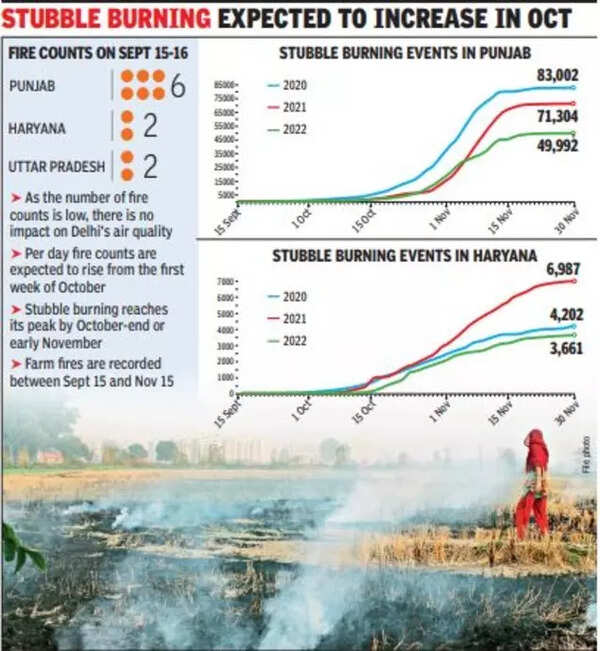[ad_1]
According to Indian Agricultural Research Institute (IARI), which follows the standard protocol 2021 notified by the air quality overseer Commission for Air Quality Management in Delhi and NCR, six crop residue burning episodes took place in Punjab’s Amritsar, two in Haryana’s Sonipat and Rohtak and two in Uttar Pradesh’s Deoria on September 15 and 16.

“Due to cloud cover following rain, the satellites did not detect farm fires on Sunday and Monday,” said professor Vinay Sehgal, principal scientist and in-charge, Consortium for Research on Agroecosystem Monitoring and Modelling from Space Laboratory, IARI.
Data from IARI shows that between September 15 and 18 last year, satellites detected 23 fires in the neighbouring states. In the same period, in 2021 and 2020, the counts were 12 and 34.
Stubble burning is not the only source for the toxic air that envelops Delhi every winter. But it is certainly a significant cause. However, as the latest figures show, the elephant in the room continues to run riot. Authorities must act immediately. Unless proper measures are taken to minimise it, the capital can never breathe easy.
“The farm fires are likely to go up from September 20 in north Punjab, including Amritsar and Tarn Taran. It is a potato-belt and early harvesting starts here. However, the peak burning is at October-end or early November,” said Sehgal. At its peak, a single day count of fires exceeds 3,000. Stubble burning generally ends in Punjab and Haryana by November 25.
Between September 15 and November 30 last year, the paddy stubble fire counts in Punjab, Haryana and Uttar Pradesh were, respectively, 49,922, 3,661 and 3,071.
Experts said the impact of stubble burning on Delhi’s air quality will show after the monsoon withdraws from north-west India and calm conditions set in. Much also depends on wind direction and wind speed.
Anumita Roychowdhury, executive director, research and advocacy, Centre for Science and Environment, said the early signs of farm fires required immediate implementation of the strategy to contain such fires this winter. “Improve farmers’ access to the machines needed to mulch the crop residues. Scale up off-farm applications like using biomass as industrial fuel or producing bio CNG from crop residues,” she said. “This can be an economic incentive for the farmers, but the infrastructure for collection and storage of straw needs strengthening. This also requires intense communication and outreach strategies.”
[ad_2]
Source link





Join The Discussion